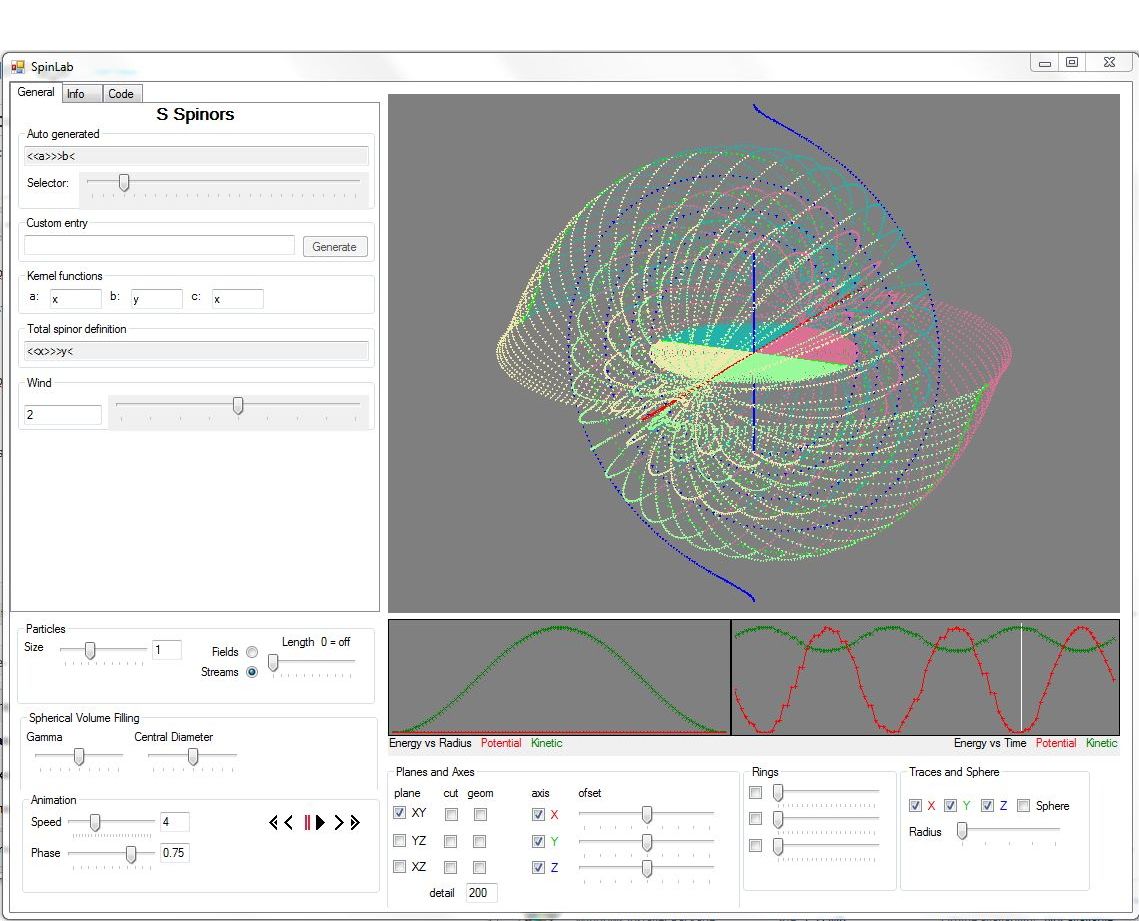SPIN LAB
SpinLab is a real-time 3D application for the exploration of spinors. It is provided free for education and research at all levels. It was created to provide a tool for users to develop an intuitive understanding of spinors. It also provides a platform for the research into spinors.
SpinLab introduces a new method and class of spinors developed by Mark Snoswell - the S-Spinors.
SpinLab is implemented with the SlimDX DirectX wrapper and implements the spinors as run-time configurable DirectX shaders. It runs on any modern version of Windows and requires a DX10 or better graphics card.
Research and Education tool
SpinLab is intended as both a research and educational tool. It is freely available and we are committed to keeping it free.
It is not claimed to be definitive or comprehensive. The spinors included are visually spinors and where possible links to previous formulations of spinors are shown.
The intention is that we can make future versions extensible -- so users can input their own spinor formulations. The graphics pipeline has been implemented with run-time compiled shaders which has allowed us to implement a parser so users can enter their own S-Spinor formulae.
For now we welcome feedback and requests for new features and spinor implementations which we will endeavor to implement as quickly as possible.
Visualization & Spinor space
SpinLab implements spinors as a space warp with DirectX shaders. This creates a distorted spinor space into which graphics objects are introduced to visualize the spinors. Currently there are planes, spheres, rings, particles, axis lines, stream's and paths. The animation speed can also be varied over a very wide range from zero (paused) to fast enough so that the display blurs out. The high speed displays can be useful as they eye averages out motion revealing features not easily seen otherwise.
The 3D view is fully interactive with rotate and zoom capabilities. To aid visual analysis the 3D projection is orthographic -- perspective projection distorts relative areas and curve shapes making some visual analysis more difficult.
All of the graphics elements are consistently colour coded to aid visual intpretations of complex spin distortions of space.
Energy displays
At present all spinors are modeled as a spherical rotation dependent on radius and time. This method permits easy differentiation with respect to both radius and time which in turn makes calculation of potential and kinetic energies relatively easy in the CPU. In the future we plan to add the ability for space to deform freely (no rigid shells of rotation). When we implement unconstrained deformation we will also implement full volumetric energy calculations as vertex shaders in the GPU.
Below the 3D window are two energy plots. The first plots potential and kinetic energy vs. radius for the current time. The second plot shows potential and kinetic energy for the entire spin volume vs. time. This reveals features of the spinors that can't be deduced from the 3D view.
S-Spinor
In April 2011 Mark Snoswell discovered a new method for creating spinors based on a simple new similar matrix paradigm. The method provides a new conceptual way of creating spinors – a conceptual method that is simpler and more revealing of the nature of spinors than anything we are aware of from the past.
Following their discovery the method was rapidly expanded to encompass known spinor types and to develop an extended set of new spinors. In the first release there are 25 basic S-Spinors encoded in the interface with every possible variation of parameters. This yields literally hundreds of unique spinors.
Although not proven, we believe that the S-Spinors can be used to describe all spinors and we look forward to researchers in the field to show if this is the case or not.
Libration Spinors
Librations are oscillating rotations. In Jan 2005 Mark Snoswell discovered a method for creating spinors from nested librations. Nested librations offer an intuitive approach to understanding the construction of a spinor and the distribution of harmonic energy within it. Nested librations can be used to describe any spinor. At present the libration spinors are not included... We want to develop an automatic conversion method from S-Spinor to L-Spinor descriptions. Ideally we can discover a bidirectional conversion so we can flip between the two spinor description methods.
3D Visualization Objects
There is a wide range of display options for visualization. In general these are 3D objects and particles that are placed within the Spinor Space. They are distorted by the spinor allowing us to visualize the resulting spinor space distortion.
Currently there are planes, spheres, rings, particles, axis lines, stream's and paths. We have experimented with other display modes and selected just those that provide the best insights into the distortions of spinor space. The visibility of objects is user selectable so they can be viewed independently or together. The user can also move the objects along an axis or radially (where appropriate) to reveal how the spin space evolves.

Copyright © 2025. Chava Science.